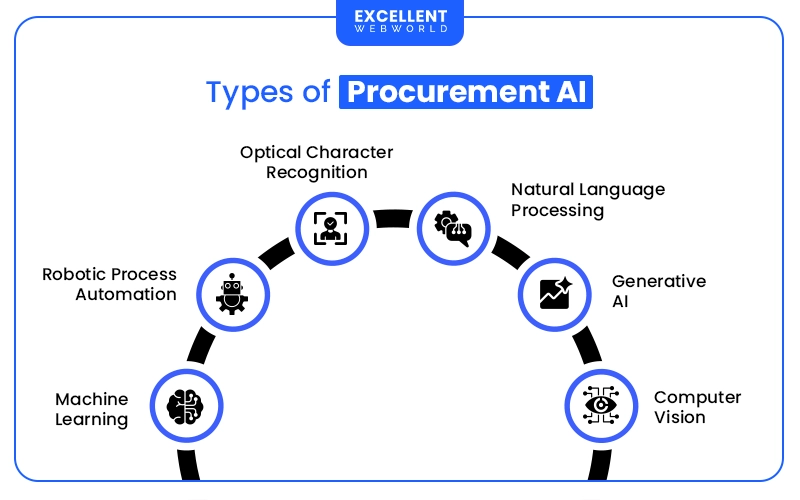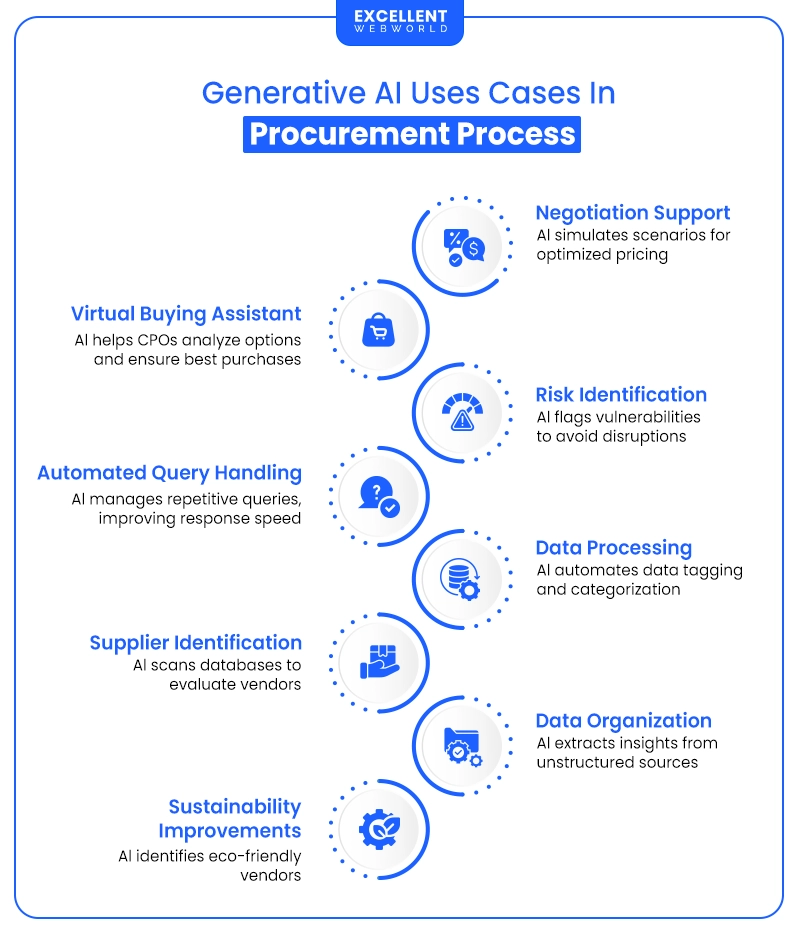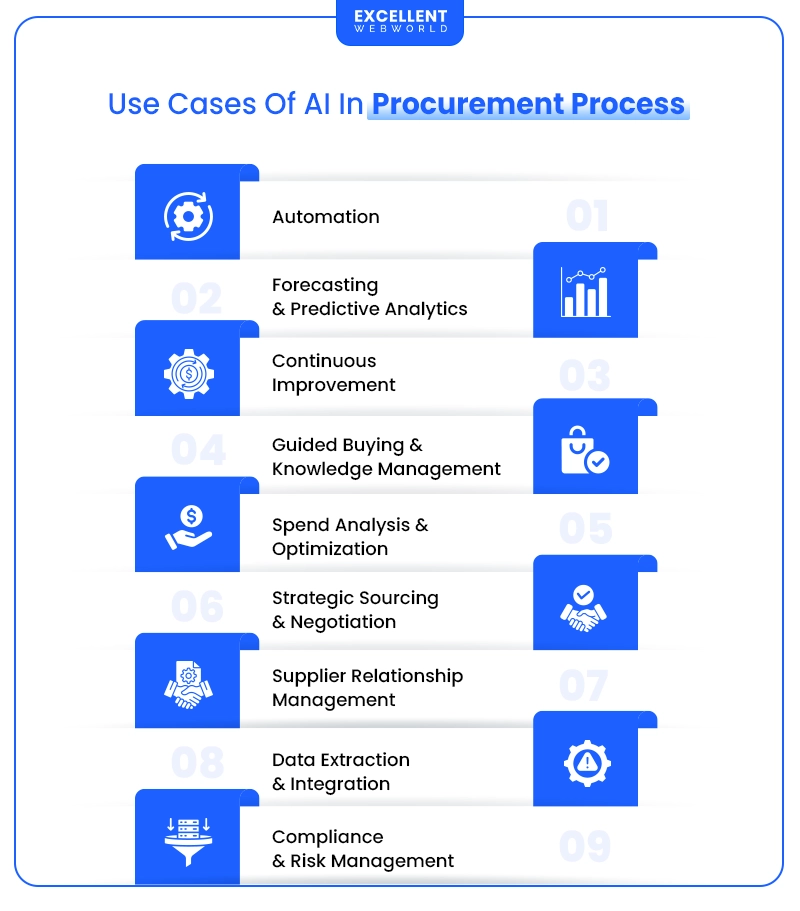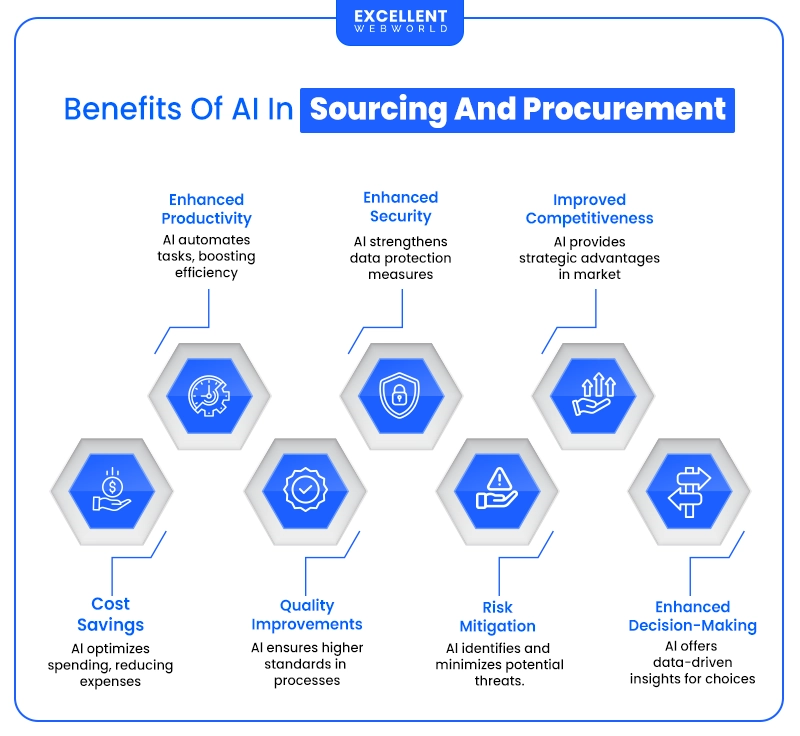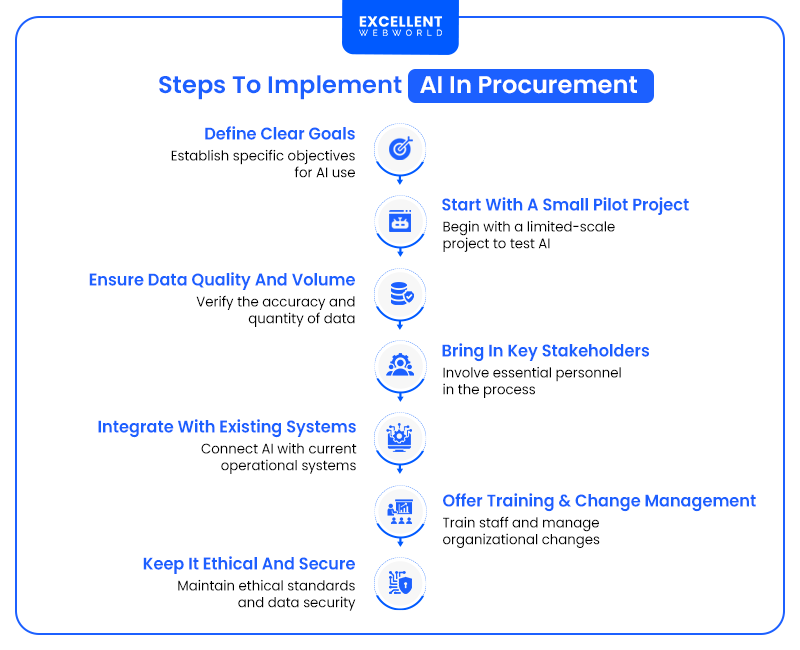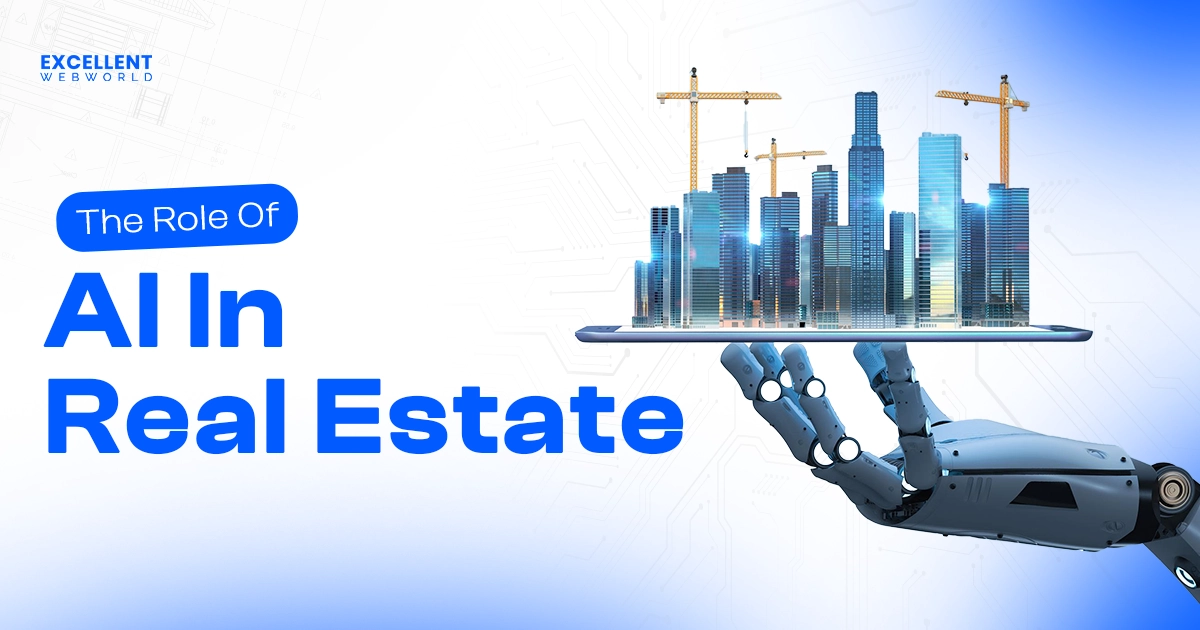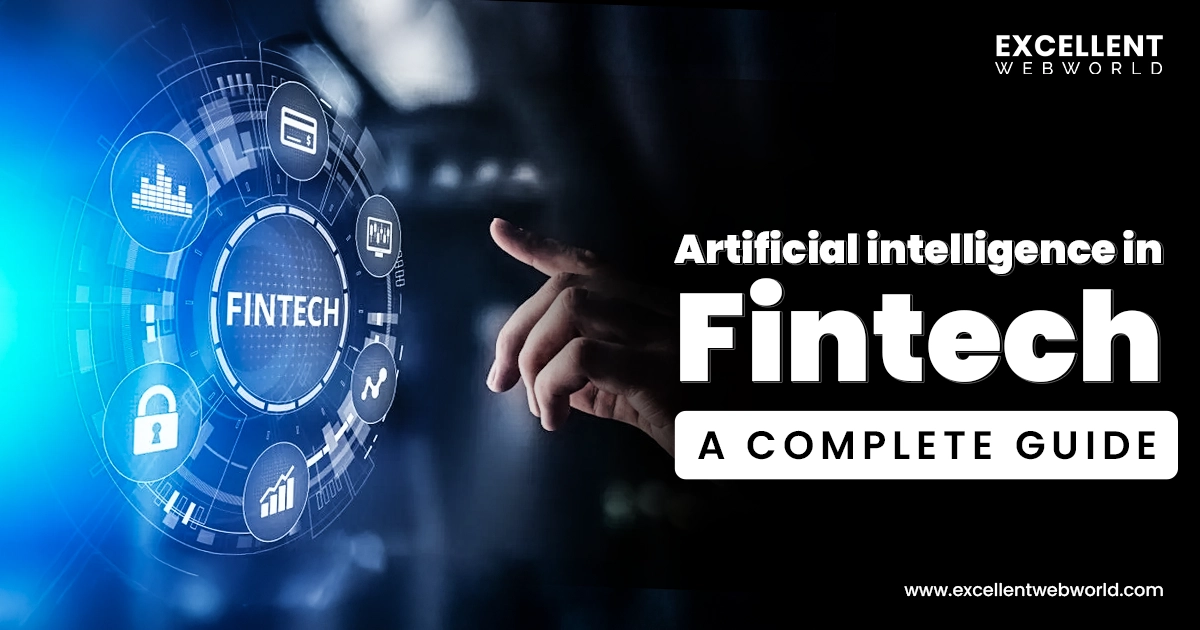While you’re stuck with slow, manual processes, your competitors are pacing ahead using AI in procurement to:
Every day you wait, they get further ahead.
Artificial intelligence in procurement helps with cost savings, predicts supply issues and handles negotiations automatically to make sourcing smarter, not just faster.
Companies betting big on AI and generative AI for procurement aren’t just saving money—they’re building procurement systems so good that they’re giving nightmares to their respective market competition.
You don’t have to wait to be one of them. This complete guide covers everything you need to know about AI in procurement:
This AI in procurement guide is created by our team of AI experts who have over 13+ years of experience in developing software the traditional way across industries. We’ve shipped over 900+ digital solutions in industries including logistics, oil & gas, healthcare, education, retail, sports, entertainment, travel, fintech, real estate, and more. Founders of funded startups, government establishments, SMBs, and enterprises seek us for business consultations to help them validate, create, and scale. Our domain expertise allows us to share our learnings with business leaders like yourself, so you don’t remain stuck when the world is moving ahead, powered by AI.
What Is Artificial Intelligence In Procurement?
AI in procurement uses advanced technologies like machine learning, natural language processing, and computer vision to optimize the procurement process, improving efficiency, accuracy, and decision-making. It provides a system for managing complex data, predicting market trends, and reducing risks.
If you are a sourcing manager, this can mean,
How Is AI Used In Procurement processes?
AI-powered procurement tools are used in operations across industries to,
What Are The Types of Procurement AI?
The adoption of AI in procurement processes is increasing due to the demand for efficient processes. Technologies like ML and NLP are fueling this adoption. Such technologies allow sourcing managers to automate spending analysis and vendor matching processes. The types of procurement AI are as follows:
1. Machine Learning (ML)
ML algorithms provide capabilities for the adoption of AI in procurement, enabling,
2. Natural Language Processing (NLP)
While ML can help you identify spending patterns, NLP powers AI procurement software to understand and process human language. This allows you to get insights into vendor communications. Plus, you can leverage custom AI development services to create voice-based systems that offer real-time insights for RFQs and contracts.
3. Robotic Process Automation (RPA)
RPA uses bots to automate repetitive tasks and optimize business process automation. So, if you are a CPO manager looking to use AI-based RPAs for efficiency, here is how you can use them,
4. Generative AI
Generative AI is changing how specific contracts, purchase requests, and RFQs are prepared. So, if you want to automate tasks like content creation for contracts, email templates, and reports, create custom generative AI models. You can leverage a generative AI development company to create custom models that create unique contract templates for your business.
5. Optical Character Recognition (OCR)
AI-powered OCR can help you optimize the decision-making process of your procurement process. According to the ProcureCon CPO report 2025, 66% of respondents focus on using AI in the procurement process for better decision-making. OCR with AI-based capabilities can automatically extract data from contracts, RFQs, and other documents. It helps you with key insights into operations and the need for procurement.
6. Computer Vision
Like OCR, computer vision is another type of procurement AI that uses visual data to manage inventory. It uses multiple cameras and sensors, which provide real-time data analyzed by AI algorithms to offer deeper insights into operations.
Computer vision helps you with,
All of these types offer unique benefits for the procurement and sourcing process. For example, you can automate content creation using generative AI procurement models and help process large unstructured datasets. However, the use of generative AI in the procurement process does not end here. If you’re unclear which is right for you or whether you’re ready to go AI, consider contacting business consulting experts who can guide you on the right track.
What Are The Uses of Generative AI in Procurement?
Generative AI can be used in procurement, from data interpretation to strategic decision-making and identifying operational risks.
Some of the key uses of generative AI in the procurement process are,
1. Virtual Buying Assistant & Guided Buying
If you are a CPO, generative AI in procurement models can act as a virtual buying assistant. It reduces the time needed to analyze all the options during procurement and ensure the best purchases for your organization.
You can hire AI developers experienced in customizing generative AI algorithms to build a model for guided buying during procurement. Using a custom generative AI buying assistant, you can find the right suppliers quickly, ensuring compliance with organizational policies.
2. Automated Query Handling
Generative AI can help your procurement teams handle queries automatically. Moreover, building custom AI-powered agents can assist in handling repetitive queries from suppliers or internal stakeholders about RFQs, PO status, or delivery ETAs. It improves response speed, reduces workload, and improves transparency across operations. You can integrate generative AI into your query response system with custom CRM software development.
3. Supplier Identification & Evaluation
If you are a procurement specialist, you can use generative AI to scan databases, contract records, and external supplier benchmarks automatically. The system evaluates vendors based on delivery reliability, financial stability, and compliance, helping reduce procurement costs in large-scale distribution networks.
4. Negotiation Support & Market Intelligence
Similarly, sourcing specialists can use generative AI to simulate negotiation scenarios and recommend optimized pricing, payment terms, and service levels. Such procurement AI models use real-time market data to offer intelligent decision-making.
5. Data Organization and Summarization
Operations managers can use generative AI to extract procurement insights from unstructured sources like contracts, invoices, and emails. It delivers actionable insights into a unified dashboard.
This is ideal for companies undergoing ERP modernization, enabling smoother integration. Using custom ERP development services, you can integrate generative AI models to improve decision-making across procurement functions.
6. Data Processing and Labeling
As a sourcing manager, generative AI helps you automate tagging and categorizing procurement data. For example, you can categorize procurement data based on product types, service classifications, or spend categories. It also helps create structured datasets essential for forecasting and procurement optimization.
7. Risk Identification
Compliance teams in your organization can use generative AI models to analyze supplier financials, performance lags, contract inconsistencies, and global events. It flags real-time vulnerabilities, helps avoid disruptions, and maintains consistent delivery standards.
8. Sustainability Improvements
Unlike risk identification, maintaining sustainability has become challenging because you must find a vendor with a minimal carbon footprint. So, if you are a procurement head looking for sustainable options, generative AI helps you identify green vendors, evaluate carbon footprints, and suggest eco-friendly alternatives.
What Are The AI Procurement Use Cases?
Use of AI in logistics, warehousing, and sourcing management is transforming procurement workflows. Whether you’re a procurement manager, understanding how AI can optimize procurement helps maximize ROI, reduce risks, and speed up operations.
Here are the most valuable AI procurement use cases based on common challenges across the industries:
1. Repetitive Procurement Task Automation
Manual sourcing and procurement workflows often involve tedious steps such as data entry, chasing approvals, and document matching. AI procurement software can automate these tasks, enabling your team to focus on strategic decisions.
2. Forecasting & Predictive Analytics
Procurement AI models improve the accuracy of demand forecasting and cost prediction, reducing stockouts, overordering, and budget variances. Plus, you need visualization tools to get clear insights from AI procurement models. You can build dashboards that provide real-time visualizations using custom software development services.
3. Spend Analysis & Optimization
Generative AI tools can process massive volumes of procurement data to reveal cost-saving opportunities across categories, vendors, and geographies. However, building such an advanced model requires customization. You must ensure the algorithms are trained with your custom data.
4. Supplier Relationship Management
AI in procurement enhances how procurement teams evaluate, monitor, and collaborate with suppliers, mitigating risk and improving long-term relationships.
5. Compliance & Risk Management
AI in procurement helps firms reduce fraud and regulatory risk by automating compliance checks and anomaly detection.
6. Guided Buying & Knowledge Management
AI simplifies indirect procurement by guiding internal stakeholders to approved vendors, helping enforce policy without manual oversight.
7. Strategic Sourcing & Negotiation
AI empowers teams with data-driven insights for smarter sourcing decisions and more effective vendor negotiations.
8. Data Extraction & Integration
Legacy procurement systems often suffer from siloed data. AI enables seamless data extraction and real-time integration across platforms.
9. Continuous Improvement
AI supports ongoing procurement optimization through feedback loops, benchmarking, and process intelligence. Using the AI-enabled systems, procurement teams can analyze supplier performance and ensure.
10. Other Emerging Use Cases
Next-gen AI use cases are helping procurement leaders drive innovation, resilience, and sustainability. Some of the emerging use cases that are set to redefine the use of AI in procurement are,
These use cases define how AI can be used in the procurement process. However, knowing the use cases is not enough—you need to see the business outcomes they offer.
Benefits of AI In Sourcing And Procurement
AI in procurements offers several business benefits, from improved productivity to cost savings and quality improvements.
1. Enhanced Productivity
Use of AI in procurement can reduce time-consuming tasks like invoice matching, vendor communications, and purchase order tracking. This frees procurement teams more time to focus on costing strategies and negotiations.
2. Cost Savings
If you are a procurement head, AI in sourcing can help you identify hidden costs. These can include the cost of delayed supplier deliveries, purchase order errors, and inventory issues.
You can also build custom software that uses AI for predictive analytics to offer purchase recommendations and reduce procurement costs. However, before developing one for your business, you must consider the total software development cost, including AI integrations.
3. Quality Improvements
3PL companies can improve the quality of materials they procure by using AI to,
4. Enhanced Security
Data security in procurement is crucial, and AI ensures robust information protection. It also helps ensure compliance with global data standards. Plus AI in procurement also helps in,
5. Improved Competitiveness
Faster sourcing cycles can reduce the time-to-market by 34%, and this is an advantage no business will miss out on. You can leverage AI procurement software to reduce the sourcing cycle.
Plus, it offers,
6. Enhanced Decision-Making
The use of artificial intelligence in procurement has been beneficial for sourcing teams in terms of decision-making. With demand forecasting capabilities and insights into the procurement process, AI enables better decision-making.
Plus, it offers,
7. Risk Mitigation
Sourcing directors facing increasing disruption risks can use AI procurement software to increase visibility and create contingency plans. Plus, using generative AI in procurement can also offer,
Challenges of Implementing AI In Procurement
Here are the key challenges that sourcing managers face while implementing AI in the procurement process,
How to Use AI in procurement: Best practices
Implementing AI in procurement requires more than tools—it demands strategic alignment, clean data, and user readiness. Follow these best practices to ensure your AI investments deliver measurable ROI and agility.
1. Define Clear Goals
Before deploying AI procurement software, clarify your goals. Ask your team whether AI will reduce cycle times, improve supplier risk visibility, or automate contract processing. Plus, you can define specific goals like
Pro Tip: Use the SMART framework (Specific, Measurable, Achievable, Relevant, Time-bound) to set procurement AI goals that align with business KPIs.
2. Start With A Small Pilot Project.
Pilot AI tools in a limited scope, gather feedback, and iterate before rolling them out organization-wide. If you are a startup, you can build an MVP first of AI procurement models. Leveraging custom software development for startups, you can create such an MVP. In addition, you must focus on building internal expertise and understanding to maximize the benefits and avoid pitfalls.
Pro Tip: To showcase early ROI, pick a use case with high visibility but low risk, like automating RFP draft generation.
3. Ensure Data Quality And Volume.
Ensure procurement data is accurate, up-to-date, and well-structured, as AI effectiveness depends heavily on data quality. Invest in cleaning, structuring, and enriching your procurement data before deploying AI solutions. You can consult IT project management experts to optimize data quality and ensure infrastructure readiness.
Pro Tip: Use data profiling tools to benchmark data quality before AI deployment—and fix gaps early.
4. Bring In Key Stakeholders.
Use AI to draft, refine, and clarify communications with suppliers and internal stakeholders, improving clarity and efficiency, especially in global teams. You can also leverage AI procurement models to structure intake forms and gather well-defined requirements from stakeholders. To frame your intake forms strategically, you can also consult with Business IT experts, ensuring better alignment with stakeholders’ goals.
Pro Tip: Involve stakeholders in user testing of AI-generated outputs—it builds trust and improves adoption.
5. Integrate With Existing Systems
Integrating AI in your existing procurement systems requires assessing APIs and customizations. You can leverage custom API development to integrate AI with your ERP, P2P, SRM, and analytics platforms. Plus, ensure the data flows bidirectionally—AI needs historical and real-time inputs to generate actionable insights.
Pro Tip: Run a system integration audit before choosing AI procurement software. This will help you identify compatibility gaps and avoid costly rework later.
6. Provide Training And Change Management.
Educate teams on how AI will support—not replace—their roles. Offer role-specific training sessions and create AI champions across departments to foster buy-in.
Pro Tip: Run workshops with real AI use cases (e.g., contract clause extraction) to build hands-on confidence fast.
7. Keep It Ethical And Secure
AI in procurement must comply with data privacy laws, cybersecurity standards, and ethical use policies. Ensure models don’t exhibit bias or expose sensitive supplier data.
Pro Tip: Use explainable AI tools that let users audit how procurement recommendations were made, especially for supplier scoring or bid evaluations.
How Excellent Webworld Can Help Implement AI In Procurement?
AI in procurement is no longer a futuristic concept—it’s today’s advantage for sourcing managers who want to move faster, spend smarter, and stay resilient. Using technologies like machine learning and generative AI, your competitors are already racing ahead!
But off-the-shelf tools won’t help you get ahead or even catch up.
At Excellent Webworld, we specialize in building AI-driven software tailored to your procurement goals, automating RFQs, integrating generative AI for strategic sourcing, or creating predictive analytics dashboards that surface hidden risks.
With 13+ years of experience delivering custom digital solutions for logistics, 3PLs, and warehouse management firms, our team blends industry knowledge with deep AI expertise to solve procurement bottlenecks, not just patch them.
Contact us to build your AI-powered procurement solution!
What Do You Get With AI Procurement Solutions From Excellent Webworld?
FAQs
AI is used in the procurement process to automate sourcing, supplier data analysis, and risk prediction. It helps sourcing managers streamline vendor selection, demand forecasting, procurement, and employ predictive analytics.
The best AI for procurement depends on what your business needs. For example, it can provide supplier risk analytics if your goal is quickly find the best materials. Plus, it can help you verify the quality of materials through advanced analytics that analyze the vendor’s past delivery patterns.
Generative AI in procurement can help you draft contracts automatically, generate supplier insights, and automate RFP responses. It can also improve your firm’s decision-making capabilities.
ERP, or Enterprise Resource Planning, integrates purchasing with inventory, finance, and vendor management. However, it is different from CRM. This is important because vendor management includes communications, which fall under CRM. So, you need to understand the difference between ERP vs CRM while developing AI in procurement features for vendor management.
You can improve the procurement process by using AI to automate repetitive tasks, predict supplier risks, centralize data, and enhance collaboration.
Common challenges include poor data quality, integration issues with legacy systems, a lack of internal expertise, and resistance to change.

Article By
Mahil Jasani began his career as a developer and progressed to become the COO of Excellent Webworld. He uses his technical experience to tackle any challenge that arises in any department, be it development, management, operations, or finance.

